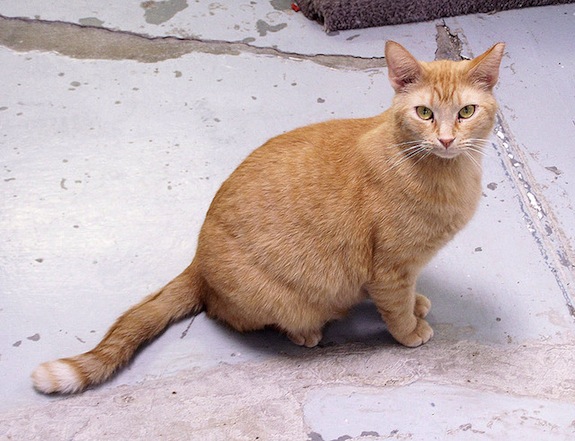There’s a Vaccine for the Cat Version of HIV. So Why Are Cats Still Getting Sick?
Understanding how cats with FIV stay healthy could help researchers figure out how to keep humans with HIV from falling ill

Eddie Jr. is a FIV+ kitty. Rocky Mountain Feline Rescue
In 2010, 34 million people on the planet were living with AIDS. But humans aren’t the only species who can get a form of HIV. There’s SIV—simian immunodeficiency virus—the form found in monkeys that might have been the predecessor to our own, human form. But there’s also FIV—feline immunodeficiency virus—a strain that affects cats.
At PLoS Blogs, Ricki Lewis describes how she found out that her cat, Juice, had FIV:
Carly and our eldest, Heather, had taken Juice for a routine physical, and the vet had picked up on persistent ear mites and swollen, bleeding gums. These were usually the earliest signs, she said, while sampling his blood to test for FIV antibodies.
Researchers have known about FIV for quite a long time, Ricki says:
Also in 1985, Niels Pedersen, DVM, PhD and Janet Yamamoto, PhD, and colleagues from the University of California, Davis heard about “a peculiar outbreak of disease” at a cattery in Petaluma, an hour’s drive from San Francisco. The facility housed 43 strays, some feral, in five pens. None had feline leukemia virus (FeLV).
From 1968 until 1982, all residents of the cattery had been healthy. Then pen D welcomed a newcomer, a kitten named Cy, who developed diarrhea, a drippy nose, and conjunctivitis. At age two, she miscarried. By her third year, Cy was skeletal and compulsively moved her mouth and tongue. Her gums bled and her teeth fell out. “Several blood transfusions were of temporary benefit but ultimately the emaciation, chronic infections, and anemia worsened and the cat died,” wrote the researchers.
For cats, there’s a vaccine against FIV. But often pet owners don’t spring for it, since a vaccinated cat is indistinguishable from an infected cat should the feline stray into a shelter or get lost. Cat who wind up at shelters and test positive—either from infection or vaccination—are euthanized. The shelter simply can’t risk transmitting FIV to the rest of their guests.
Just how many cats have FIV is unclear, says Cornell:
FIV-infected cats are found worldwide, but the prevalence of infection varies greatly. In the United States, approximately 1.5 to 3 percent of healthy cats are infected with FIV. Rates rise significantly-15 percent or more-in cats that are sick or at high risk of infection. Because biting is the most efficient means of viral transmission, free-roaming, aggressive male cats are the most frequently infected, while cats housed exclusively indoors are much less likely to be infected.
Cats with FIV can’t give humans HIV, but the virus is quite similar. PLoS writes:
FIV resembles HIV, shares some of its genes, but has a small, cone-like protrusion. Cats can’t transmit FIV to humans, nor can humans give HIV to cats. But FIV is more similar to HIV than are lentiviruses from goats, sheep, and horses to each other. Conquering AIDS may come from untangling the pathways of lentivirus evolution.
Just as HIV likely evolved from simian immunodeficiency virus (SIV), FIV originated from a lentivirus seen today in lions, with variants in pumas (aka mountain lions or cougars), cheetahs, and panthers. Chimps and lions live with their lentiviruses, in health.
Adopting an FIV cat from one of the few clinics that will keep them is also tricky business. Very few shelters will take them, and those who do have extensive procedures. Love and Hope Animal Sanctuary, a place that does take FIV cats, puts it this way:
FeLV cats and kittens are different. Their virus is far easier to transmit to other animals and they are usually destined to a far shorter life span, particularly if they are born with the virus. Fifty percent die by the age of one year and 80% die before they reach two years old. At the Sanctuary, we provide our FeLV cats with special vitamins and immune enhancing drugs in the hope of keeping them healthy for as long as possible. The fact is that these cats are “healthy” until their immune system breaks down. We cannot know how long these special creatures will live, but we ensure that they will have fun, and lots of love and care for as long as they are here.
For Ricki, adopting another FIV cat involved a visit from the cat social worker.
We’d recently lost a brother-sister pair to very old age, which was in our favor. When the cat social worker sat at our dining room table and started shuffling papers, the remaining 3 Lewis cats jumped up to investigate. Juice rubbed his perpetually runny nose on the visitor, as we recited the genealogy of all our cats, tortoises, assorted rodents and lagomorphs, and hedgehog.
The social worker then asked a series of questions.
“If the new cat peed on the floor, what would you do?”
Clean it up.
“If the cat vomited on your bed, what would you do?”
Change the sheets.
“If the cat seemed upset, what would you do?”
Talk to him.
We passed.
Two weeks later, the nice cat lady delivered Artie, and a huge contraption that unfolded into a cage. We set it up in my office.
Understanding how cats with FIV stay healthy could help researchers figure out how to keep humans with HIV from falling ill. FIV positive cats can live for ten years without getting sick – which isn’t the case, generally, for humans.
More from Smithsonian.com:
HIV in 3-D
Hemingway’s Old Man Inspires Shark Oil for HIV Vaccine
/https://tf-cmsv2-smithsonianmag-media.s3.amazonaws.com/accounts/headshot/Rose-Eveleth-240.jpg)
/https://tf-cmsv2-smithsonianmag-media.s3.amazonaws.com/accounts/headshot/Rose-Eveleth-240.jpg)